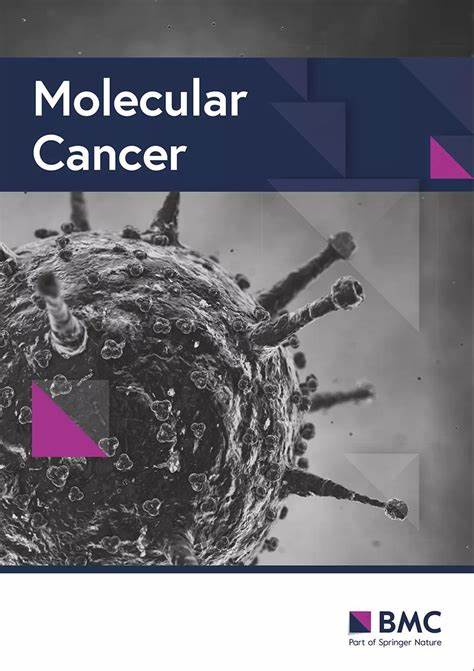Hsa_circ_0125356 promotes gemcitabine resistance by modulating WNT canonical and non-canonical pathways via miR-582-5p/FGF9 axis in non-small cell lung cancer
IF 27.7
1区 医学
Q1 BIOCHEMISTRY & MOLECULAR BIOLOGY
引用次数: 0
Abstract
Non-small cell lung cancer (NSCLC) is the leading cause of cancer morbidity and mortality worldwide. The prognosis of patients has been significantly improved by chemotherapy, but acquired drug resistance remains a major obstacle to NSCLC treatment. Circular RNAs (circRNAs), which act as miRNA or protein sponges, are critically associated with the development and chemotherapy resistance of NSCLC. CircRNA sequencing was performed to analyze the differential expression of circRNAs between A549 and A549-GR cells. Chromogenic in situ hybridization (CISH) and immunohistochemistry (IHC) technologies were used to detect the expression of hsa_circ_0125356, miR-582-5p,and FGF9 in NSCLC tissues and para-carcinoma tissues. Fluorescence in situ hybridization (FISH), dual-luciferase reporter assays and RNA immunoprecipitation (RIP) were conducted to evaluate the expression and regulation of hsa_circ_0125356, miR-582-5p, and FGF9. Furthermore, the regulation of hsa_circ_0125356/miR-582-5p/FGF9 on gemcitabine sensitivity was confirmed by TUNEL, Transwell, EdU, CCK8 and immunohistochemistry. We identified a novel hsa_circ_0125356 as a therapeutic target against gemcitabine resistance. Hsa_circ_0125356 was significantly elevated in clinical samples of patients with NSCLC. Moreover, hsa_circ_0125356 overexpression promoted gemcitabine resistance to NSCLC by upregulating FGF9 via sponging miR-582-5p in vivo and in vitro. Notably, WNT canonical (ERK/GSK3β/β-catenin) and non-canonical (Daam1/RhoA/ROCK2) signaling pathways were activated due to hsa_circ_0125356 acting as an endogenous miR-582-5p sponge to regulate the expression of FGF9, and thereby enhancing gemcitabine resistance via promoting DNA damage repair and inhibition of apoptosis. The results were further confirmed by two small molecule antagonists, WAY 316606 and XAV-939,which could inhibit the activation of WNT signaling pathway induced by hsa_circ_0125356. We first demonstrated that hsa_circ_0125356 was significantly upregulated and served as a biomarker for gemcitabine resistance in NSCLC by sponging miR-582-5p/FGF9 axis to regulate the WNT canonical and non-canonical signaling pathways, which provided a new direction for identification of therapeutic targets for the treatment of gemcitabine resistance of NSCLC.在非小细胞肺癌中,Hsa_circ_0125356通过miR-582-5p/FGF9轴调节WNT规范和非规范通路,促进吉西他滨耐药
非小细胞肺癌(NSCLC)是全球癌症发病率和死亡率的主要原因。化疗已显著改善患者预后,但获得性耐药仍是NSCLC治疗的主要障碍。环状rna (circRNAs)作为miRNA或蛋白海绵,与NSCLC的发展和化疗耐药密切相关。进行CircRNA测序,分析A549和A549- gr细胞中CircRNA的差异表达。采用显色原位杂交(CISH)和免疫组化(IHC)技术检测hsa_circ_0125356、miR-582-5p和FGF9在NSCLC组织和癌旁组织中的表达。通过荧光原位杂交(FISH)、双荧光素酶报告基因测定和RNA免疫沉淀(RIP)来评估hsa_circ_0125356、miR-582-5p和FGF9的表达和调控。此外,通过TUNEL、Transwell、EdU、CCK8和免疫组织化学证实hsa_circ_0125356/miR-582-5p/FGF9对吉西他滨敏感性的调节作用。我们确定了一种新的hsa_circ_0125356作为抗吉西他滨耐药的治疗靶点。Hsa_circ_0125356在NSCLC患者的临床样本中显著升高。此外,hsa_circ_0125356过表达在体内和体外通过海绵化miR-582-5p上调FGF9,促进了吉西他滨对NSCLC的耐药。值得注意的是,由于hsa_circ_0125356作为内源性miR-582-5p海绵调节FGF9的表达,从而通过促进DNA损伤修复和抑制细胞凋亡来增强吉西他滨耐药性,WNT规范化(ERK/GSK3β/β-catenin)和非规范化(Daam1/RhoA/ROCK2)信号通路被激活。两种小分子拮抗剂WAY 316606和XAV-939可抑制hsa_circ_0125356诱导的WNT信号通路激活,进一步证实了上述结果。我们首先通过miR-582-5p/FGF9轴调控WNT规范和非规范信号通路,证明hsa_circ_0125356在NSCLC中显著上调并作为吉西他滨耐药的生物标志物,为治疗NSCLC吉西他滨耐药的治疗靶点的鉴定提供了新的方向。
本文章由计算机程序翻译,如有差异,请以英文原文为准。
求助全文
约1分钟内获得全文
求助全文
来源期刊

Molecular Cancer
医学-生化与分子生物学
CiteScore
54.90
自引率
2.70%
发文量
224
审稿时长
2 months
期刊介绍:
Molecular Cancer is a platform that encourages the exchange of ideas and discoveries in the field of cancer research, particularly focusing on the molecular aspects. Our goal is to facilitate discussions and provide insights into various areas of cancer and related biomedical science. We welcome articles from basic, translational, and clinical research that contribute to the advancement of understanding, prevention, diagnosis, and treatment of cancer.
The scope of topics covered in Molecular Cancer is diverse and inclusive. These include, but are not limited to, cell and tumor biology, angiogenesis, utilizing animal models, understanding metastasis, exploring cancer antigens and the immune response, investigating cellular signaling and molecular biology, examining epidemiology, genetic and molecular profiling of cancer, identifying molecular targets, studying cancer stem cells, exploring DNA damage and repair mechanisms, analyzing cell cycle regulation, investigating apoptosis, exploring molecular virology, and evaluating vaccine and antibody-based cancer therapies.
Molecular Cancer serves as an important platform for sharing exciting discoveries in cancer-related research. It offers an unparalleled opportunity to communicate information to both specialists and the general public. The online presence of Molecular Cancer enables immediate publication of accepted articles and facilitates the presentation of large datasets and supplementary information. This ensures that new research is efficiently and rapidly disseminated to the scientific community.
 求助内容:
求助内容: 应助结果提醒方式:
应助结果提醒方式:


